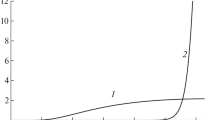Abstract
It has been shown that the conclusion of the linear instability of the Hagen-Poiseuille flow at finite Reynolds numbers requires the refusal of the use of the traditional “normal” form of the representation of disturbances, which implies the possibility of separation of variables describing disturbances as functions of the radial and longitudinal (along the axis of a tube) coordinates. In the absence of such separation of variables in the developed linear theory, it has been proposed to use a modification of the Bubnov-Galerkin theory that makes it possible to take into account the difference between the periods of the longitudinal variability for different radial modes preliminarily determined by the standard application of the Galerkin-Kantorovich method to the evolution equation of extremely small axisymmetric disturbances of the tangential component of the velocity field. It has been shown that the consideration of even two linearly interacting radial modes for the Hagen-Poiseuille flow can provide linear instability only in the presence of the mentioned conditionally periodic longitudinal variability of disturbances along the axis of the tube, when the threshold Reynolds number Reth(p) is very sensitive to the ratio p of two longitudinal periods each describing longitudinal variability for its radial disturbance mode. In this case, the threshold Reynolds number can tend to infinity, Reth(p) → ∞, only at p = p k = k, p = p 1/k = 1/k, and \(p = p_{\sqrt k } = [k + 1 \pm \sqrt {(k + 1)^2 - 4} ]/2\), where k = 1, 2, 3, …. The minimum Reynolds number Reth(p) ≈ 448 (at which p ≈ 1.527) for the linear instability of the Hagen-Poiseuille flow quantitatively corresponds to the condition of the excitation of Tollmien-Schlichting waves in the boundary layer, where Reth = 420. Similarity of the mechanisms of linear viscous dissipative instability for the Hagen-Poiseuille flow and Tollmien-Schlichting waves has been discussed. Good quantitative agreement has been obtained between the phase velocities of the vortex disturbances and the experimental data on the velocities of the leading and trailing edges of turbulent “puffs” propagating along the axis of the tube.
Similar content being viewed by others
References
O. Reynolds, Proc. R. Soc. London 35, 84 (1883).
D. Joseph, Stability of Fluid Motions (Springer-Verlag, Heidelberg, Germany, 1976; Mir, Moscow, 1981).
P. G. Drazin and N. H. Reid, Hydrodynamic Stability (Cambridge University Press, Cambridge, United Kingdom, 1981).
L. D. Landau and E. M. Lifshitz, Course of Theoretical Physics, Volume 6: Fluid Mechanics (Butterworth-Heinemann, Oxford, 2000; Nauka, Moscow, 2006).
S. Grossman, Rev. Mod. Phys. 72, 603 (2000).
R. Fitzegerald, Phys. Today 57, 21 (2004).
H. Faisst and B. Eckhardt, Phys. Rev. Lett. 91, 224502 (2003).
H. Wedin and R. Kerswell, J. Fluid Mech. 508, 333 (2004).
T. M. Schneider, B. Eckhardt, and J. A. Yorke, Phys. Rev. Lett. 99, 034502 (2007).
J. D. Skufca, J. A. Yorke, and B. Eckhardt, Phys. Rev. Lett. 96, 174101 (2006).
W. Pfenniger, in Boundary Layer and Flow Control, Ed. by G. V. Lachmann (Pergamon, London, 1961), Vol. 2, p. 970.
J. A. Fox, M. Lessen, and W. V. Bhat, Phys. Fluids 11, 1 (1968).
A. S. Monin, Sov. Phys.-Usp. 29(9), 243 (1986).
R. R. Kerswell and A. Davey, J. Fluid Mech. 316, 307 (1996).
D. R. Barnes and R. R. Kerswell, J. Fluid Mech. 417, 103 (2000).
P. A. Mackrodt, J. Fluid Mech. 73, 153 (1976).
J. P. Matas, J. F. Morris, and E. Guazzlli, Phys. Rev. Lett. 90, 014501 (2003).
G. Z. Gershuni, Sorosovskii Obraz. Zh., Fiz., No. 2, 99 (1997).
L. D. Landau, Zh. Eksp. Teor. Fiz. 11, 592 (1941).
S. G. Chefranov, JETP Lett. 73(6), 274 (2001).
S. G. Chefranov, J. Exp. Theor. Phys. 99(2), 296 (2004).
S. G. Chefranov, Phys. Rev. Lett. 93, 254801 (2004).
A. S. Monin and A. M. Yaglom, Statistical Fluid Mechanics, Volume 1: Mechanics of Turbulence (Gidrometeoizdat, St. Petersburg, 1992; Dover, New York, 2007).
B. J. Cantwell, Annu. Rev. Fluid Mech. 13, 457 (1981).
Yu. S. Kachanov, V. V. Kozlov, and V. Ya. Levchenko, Origin of Turbulence in Boundary Layers (Siberian Brunch of the Academy of Sciences of the Soviet Union, Novosibirsk, 1982) [in Russian].
R. J. Leite, J. Fluid Mech. 5, 81 (1959).
S. J. Davies and C. M. White, Proc. R. Soc. London, Ser. A 69, 92 (1928).
I. J. Wygnanski and F. H. Champagne, J. Fluid Mech. 59, 281 (1973).
J. Peixinho and T. Mullin, Phys. Rev. Lett. 96, 094501 (2006).
B. Hof, C. W. H. van Doorne, J. Westerweel, and F. T. M. Neiuwstadt, Phys. Rev. Lett. 95, 214502 (2005).
G. B. Schubauer and H. K. Skramstad, Laminar Boundary-Layer Oscillations and Stability of Laminar Flow (United States National Advisory Committee for Aeronautics, Pasadena, California, United States, 1948), Rep. No. 909.
F. T. Smith and R. J. Bodonyi, Proc. R. Soc. London, Ser. A 384, 463 (1982).
F. T. Smith, D. J. Doorly, and A. P. Rothmayer, Proc. R. Soc. London, Ser. A 428, 255 (1990).
A. G. Walton, Proc. R. Soc. London, Ser. A 461, 813 (2005).
I. J. Wygnanski and F. H. Champagne, J. Fluid Mech. 59, 281 (1973).
A. P. Willis and R. R. Kerswell, Phys. Rev. Lett. 100, 124501 (2008).
A. P. Willis and R. R. Kerswell, J. Fluid Mech. 619, 213 (2009).
Author information
Authors and Affiliations
Corresponding author
Additional information
Original Russian Text © S.G. Chefranov, A.G. Chefranov, 2014, published in Zhurnal Eksperimental’noi i Teoreticheskoi Fiziki, 2014, Vol. 146, No. 2, pp. 373–383.
Rights and permissions
About this article
Cite this article
Chefranov, S.G., Chefranov, A.G. Solution to the paradox of the linear stability of the Hagen-Poiseuille flow and the viscous dissipative mechanism of the emergence of turbulence in a boundary layer. J. Exp. Theor. Phys. 119, 331–340 (2014). https://doi.org/10.1134/S1063776114070127
Received:
Published:
Issue Date:
DOI: https://doi.org/10.1134/S1063776114070127




